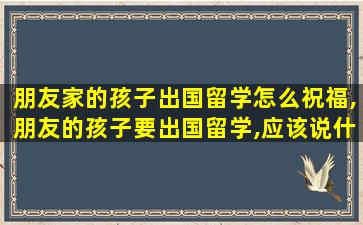出国留学过海关流程,出国留学过海关需要什么材料
- 作者: 陈浚萧
- 发布时间:2024-08-15
1、出国留学过海关流程
出国留学过海关的流程通常包括以下步骤:
1. 提前准备好必要的文件和材料,包括护照、签证、录取通知书、学生签证、学费收据、资金证明等。
2. 在离开国家前,确保自己的护照和签证有效期足够长,并且有足够的空白页。
3. 到达出发地机场后,前往海关检查站,并排队等候。
4. 出示护照、签证和其他必要的文件给海关官员进行核查。

5. 答复海关官员询问的问题,如旅行目的、行程安排、留学计划等。
6. 可能需要进行行李检查,将行李放在X光机上进行安全检查。
7. 留意海关官员发布的指示,根据要求进行必要的操作,并保持合作和耐心。
8. 完成海关检查后,提取行李并离开检查站。
注意事项:
- 在海关过程中,保持冷静和礼貌。
- 如果不确定某些文件或程序,请提前咨询相关机构或专业人士。
- 按时到达机场,以免错过登机时间。
- 在出国前,查看目的地国家的海关入境要求和禁止物品清单,以避免违反规定。
需要注意的是,不同国家、不同机场的海关过程可能会有所不同,这只是一个基本的概述。因此,在出国前,最好向所在国家的大使馆或领事馆咨询准确的过关流程和要求。
2、出国留学过海关需要什么材料
出国留学过海关通常需要以下材料:
1. 护照:确保护照的有效期至少长于计划停留的时间,并且有足够的空白页用于签证和出入境章。
2. 签证:根据目的地国家的要求,申请并获得相应的签证,如学生签证、工作签证等。
3. 录取通知书:如果是留学生签证,需要提供学校的录取通知书或学生申请的证明文件作为入境的凭据。
4. 预定的往返机票:确认你已经订好了往返的机票,以证明你计划离开国家并返回。
5. 住宿证明:提供在目的地国家的合法住宿证明,如学校提供的宿舍预订确认函、酒店预订函等。
6. 财务证明:提供足够的资金证明,以证明你有足够的经济能力支付学费、生活费和其他费用。
7. 课程注册证明:提供学校的课程注册证明,以证明你已经在目的地国家注册并选择课程。
8. 健康证明:提供健康证明或体检报告,以证明你身体健康并且没有传染病。
你可能还需要提供其他特定于目标国家的文件和材料,如学术成绩单、推荐信、语言考试成绩、犯罪记录证明等。建议提前咨询目标国家的大使馆或领事馆,了解具体的要求和程序。
3、出国留学肺结核检查流程
出国留学肺结核检查流程大致包括以下几个步骤:
1. 预约体检:在确定出国留学后,需要提前预约体检时间。可以向所在国家的使馆或领事馆或指定的医疗机构咨询具体流程和要求。
2. 体检项目:一般肺结核检查包括胸部X光检查和结核菌感染测试。胸部X光检查是一种非侵入性检查方法,可以用于发现肺部病变。结核菌感染测试一般有两种方法:皮肤试验(PPD试验)和血清学检查(IGRA试验)。具体使用哪种方法取决于所在国家的要求。
3. 结果评估:体检后,医生会对检查结果进行评估。如出现异常,可能需要进行进一步检查或治疗。
4. 体检报告:体检完成后,医疗机构会提供体检报告。这份报告需要提交给使馆或领事馆。
5. 签证申请:根据所在国家的要求,不同国家对于肺结核检查结果的要求可能不同。一般情况下,如果体检结果正常,可以正常申请签证;如果体检结果异常,可能需要提供额外的证明材料或接受治疗。
需要注意的是,不同国家的出国留学肺结核检查流程和要求可能有所不同,建议在具体出国前向所在国家的使馆或领事馆或医疗机构咨询更准确的信息。
4、出国留学过海关流程英文
The Customs Clearance Process for International Students Studying Abroad
1. Arrival at the airport: When you arrive at the airport in your destination country, proceed to the immigration counters. Keep your passport, visa, and other required documents ready.
2. Immigration check: Present your passport and visa to the immigration officer. This officer will verify your travel documents, ask about your purpose of visit (study abroad), and may ask for additional supporting documents such as your acceptance letter from the university or college, financial proof, or accommodation details.

3. Baggage claim: After passing through immigration, proceed to the baggage claim area to collect your checked-in luggage. Follow the signs or ask airport staff for assistance if needed.
4. Customs declaration form: Before clearing customs, you may be required to fill out a customs declaration form. This form typically asks you to declare any items that you are bringing into the country, especially high-value items, cash, or restricted goods. Fill out the form accurately and honestly.
5. Customs inspection: After completing the customs declaration form, proceed to the customs inspection area. Customs officers may randomly select passengers for baggage inspection. If chosen, cooperate with the customs officer, open your luggage, and provide any requested information or documentation regarding the items you are carrying.
6. Paying customs duties (if applicable): If you are bringing in goods that exceed the duty-free limits or are restricted or prohibited, you may be required to pay customs duties. The customs officer will provide you with the necessary guidance on how to pay these duties.
7. Exit from the airport: Once you have cleared customs, proceed to the airport exit to meet your designated airport pick-up or arrange for transportation to your destination.
Remember to familiarize yourself with the specific customs regulations and requirements of the country you are studying in before your travel. This will help ensure a smoother customs clearance process upon arrival.




